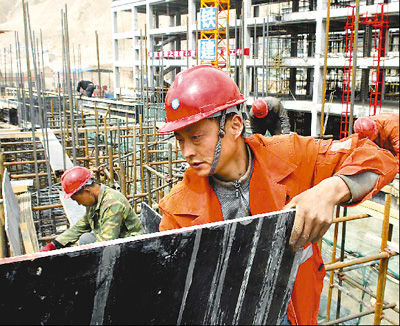A year after quake, Tibetan town faces massive rebuilding
Cranes and bulldozers are roaring. Construction workers donned in helmets and uniforms are seen every few paces.
Exactly a year after a deadly earthquake shook the predominantly Tibetan Yushu Prefecture of northwest China's Qinghai Province, a massive rebuilding project has turned the plateau town from a wasteland of rubble into a huge construction site.
Post-quake rebuilding began in Yushu on June 20 last year and hundreds of new homes and public facilities have been built.
But construction is impossible in the plateau area -- at an average altitude of 4,000 meters -- for at least seven months of the year as during the colder months even the least exertion sends one breathlessly reaching for the oxygen bottle.
A huge number of rebuilding projects were started Thursday, the first anniversary of the 7.1-magnitude earthquake that killed nearly 2,700 people and left another 270 missing in Yushu.
The Qinghai provincial government said an additional 20 billion yuan (3.06 billion U.S. dollars) had been poured into the rebuilding this year, following last year's 5 billion yuan.
The planned three-year rebuilding project will cost an estimated 31.65 billion yuan, said Shen Chuanli, deputy chief of the Qinghai provincial development and reform commission and leader of the post-quake construction headquarters.
"Now that 80 percent of the fund is in place, we'll step up building of homes, schools, hospitals, monasteries and other public facilities in all the quake-ravaged counties," said Shen.
By the end of this year, he said construction of 13 schools and two hospitals in Gyegu Town, the quake epicenter, would be completed.
Meanwhile, about 25,000 new homes are being built in all the six quake-ravaged counties of Yushu, or 70 percent of all the planned new homes to be built by 2013, said vice governor Ma Shunqing.
New life, new hope
Trangu in Gyegu is one of the worst-hit villages. Sixty-four villagers died and many homes were flattened.
The village at 4,200 meters above sea level was also among the first to be rebuilt.
"We moved into our new home in late December," said 55-year-old villager Karma Sonam. "It was the start of a very warm winter."
To date, 206 families have moved into new homes -- Tibetan-style houses with red roofs and yellow outer walls, said village official Kyian Tsering. "They are gradually walking out of the shadow of the quake nightmare and beginning to plan for their future."
Though most quake-stricken residents are still living in tents and prefabricated houses, they, too, see hope as aid pours in.
A total of 246,800 people in Yuhsu were affected by the quake, many of whom were left homeless.
To protect them from cold, hunger and contagious diseases, the central and local governments handed out 832 million yuan in cash subsidies, averaging 3,730 yuan per person, said Yushu's top prefectural official Wang Yuhu.
"The amount is equivalent to the per capita net annual income for farmers and herders in Qinghai Province last year," said Wang.
When all the 5.6 million Qinghai residents stood in silent tribute to mourn the quake dead Thursday, primary school students tearfully bowed their heads on their campus as a gesture of grief and gratitude.
A makeshift exhibition counter on the temporary campus of the Red Flag Primary School in Gyegu town was stacked with children's works: paintings and essays in memory of the dead, and models of the best possible new campus they could imagine.
"We've taught the children to have faith," said the school's principal Fu Wencai. "New homes and schools are being built, and we're all confident in our future."
 0
0 








Go to Forum >>0 Comments